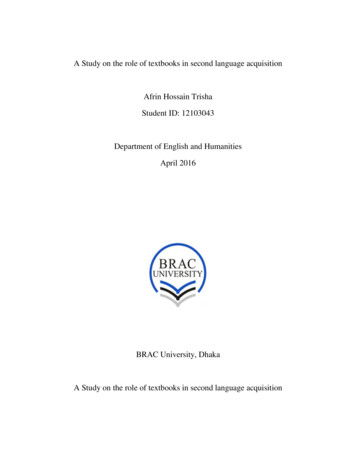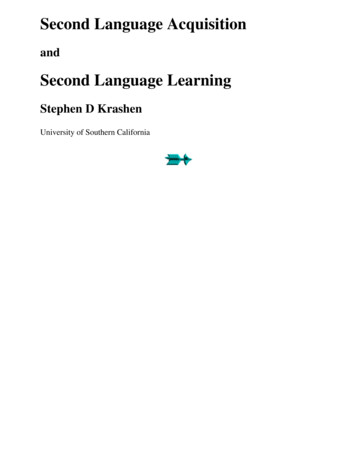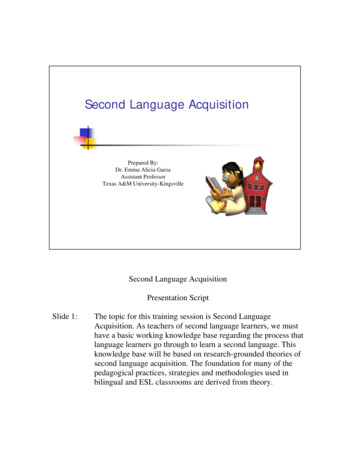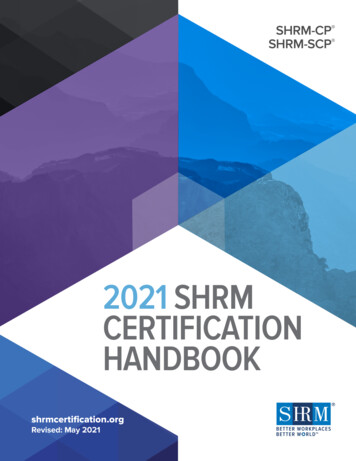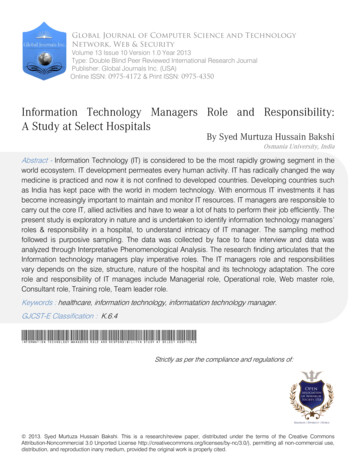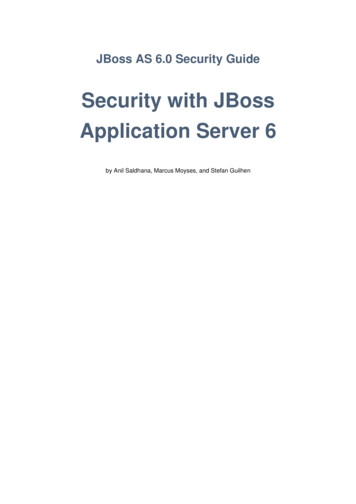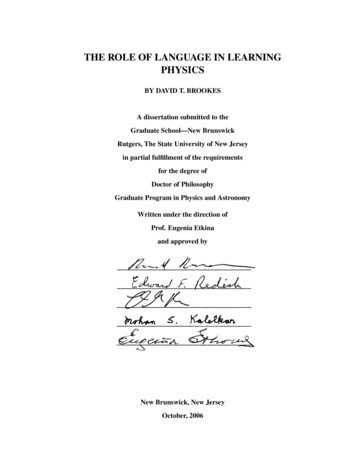
Transcription
THE ROLE OF LANGUAGE IN LEARNINGPHYSICSBY DAVID T. BROOKESA dissertation submitted to theGraduate School—New BrunswickRutgers, The State University of New Jerseyin partial fulfillment of the requirementsfor the degree ofDoctor of PhilosophyGraduate Program in Physics and AstronomyWritten under the direction ofProf. Eugenia Etkinaand approved byNew Brunswick, New JerseyOctober, 2006
c 2006David T. BrookesALL RIGHTS RESERVED
ABSTRACT OF THE DISSERTATIONThe Role of Language in Learning Physicsby David T. BrookesDissertation Director: Prof. Eugenia EtkinaMany studies in PER suggest that language poses a serious difficulty for students learning physics. These difficulties are mostly attributed to misunderstanding of specializedterminology. This terminology often assigns new meanings to everyday terms usedto describe physical models and phenomena. In this dissertation I present a novel approach to analyzing of the role of language in learning physics. This approach is basedon the analysis of the historical development of physics ideas, the language of modernphysicists, and students’ difficulties in the areas of quantum mechanics, classical mechanics, and thermodynamics. These data are analyzed using linguistic tools borrowedfrom cognitive linguistics and systemic functional grammar. Specifically, I combinethe idea of conceptual metaphor and grammar to build a theoretical framework thataccounts for the role and function that language serves for physicists when they speak andreason about physical ideas and phenomena, specific features of students’ reasoning and difficulties that may be related to orderived from language that students read or hear.ii
The theoretical framework is developed using the methodology of a grounded theoretical approach. The theoretical framework allows us to make predictions about therelationship between student discourse and their conceptual and problem solving difficulties. Tests of the theoretical framework are presented in the context of “heat” inthermodynamics and “force” in dynamics. In each case the language that students useto reason about the concepts of “heat” and “force” is analyzed using the theoreticalframework. The results of this analysis show that language is very important in students learning. In particular, students are using features of physicists’ conceptual metaphors to reason about physical phenomena, often overextending and misapplying these features, drawing cues from the grammar of physicists’ speech and writing to categorizephysics concepts; this categorization of physics concepts plays a key role in students’ ability to solve physics problems.In summary, I present a theoretical framework that provides a possible explanationof the role that language plays in learning physics. The framework also attempts toaccount for how and why physicists’ language influences students in the way that itdoes.iii
PrefaceThe dissertation is organized in the following way:In Chapter 1 I will provide a brief introduction to the broad issues of learningphysics, with some theoretical background on the approaches I will take. I will explainwhy language is important in the broader context of representations of physics knowledge. I will also try to recreate for the reader, some of my thought process that led meto think that language might be more important than generally thought.In Chapter 2, I will present a broad survey of related literature. This survey willcover relevant research on the topics of analogy, linguistics, cognitive linguistics, metaphor,systemic functional grammar, and student learning of physics. This chapter will alsoserve as an introduction to some of the linguistic analysis techniques that will be implemented in later chapters.The goal of Chapter 3 will be to try and draw the literature of Chapter 2 together,present a theoretical framework of how language in physics works, and how studentsinterpret that language. This chapter will also cover all the methodological approachesapplied to later chapters.Testing the theoretical framework and presenting the data on which it was constructed, is the goal of Chapter 4. This will be done entirely in the field of quantummechanics. I will show how the linguistic framework presented in Chapter 3 successfully describes the way physicists talk about quantum mechanical ideas. I will then usethe analysis to show how the theoretical framework is applicable to student reasoningin quantum mechanics. I will present two case studies that can be explained with thetheoretical framework.iv
Chapter 5 will be the largest chapter of my dissertation. Here I will take the theoretical framework developed in the context of quantum mechanics and show how canbe applied to the fields of thermodynamics and Newtonian mechanics. I will show howphysicists’ language can be analyzed with the tools I have developed. I will make predictions about features of students’ reasoning and test these predictions in an interviewstudy. I will also apply the linguistic analysis to reexamine the old “misconceptions”literature about force in Newtonian mechanics and show that many so-called student“misconceptions” may be reinterpreted as linguistic difficulties. Finally, I will extendthe linguistic perspective beyond the theoretical framework I developed. I will attempta second hypothesis that really connects cognition and language together as one actrather than two separate ones. This means that we can understand our students’ thoughtprocesses by listening more carefully to what they say. Listening to them through thelinguistic framework can profoundly change what we hear students saying and asking.Chapter 6 is the concluding chapter. Here I will show how the theoretical framework may help us to understand physics better. I will summarize what the thesis hasaccomplished, discuss future directions of research (particularly testing experiments)and make some general suggestions about the role of language in teaching.v
AcknowledgementsAlthough a dissertation can list only one author, I cannot claim that such a difficultintellectual endeavor is the work of one individual person. The first group of people Iwish to thank are those who made a significant intellectual contribution in the form ofideas, suggestions or challenges to my ideas. Without my advisor, Prof. Eugenia Etkina, none of these pages would exist. You have encouraged and supported me withoutquestion, offered deep insight, and challenged me more than anyone else. The idea toexplore the role of language came from my sister, Heather Brookes. Your two readingrecommendations have formed the basis of this thesis. I wish to thank Prof. GeorgeHorton for questioning my work. Without those challenges, I would never have startedexploring the role of grammar in the language of physics. Leslie Atkins’ quiet suggestions and prodding helped me to understand the cognitive mechanism of metaphorcomprehension in terms of ad hoc categorization. Prof. Alan Van Heuvelen has tirelessly supported and advocated my research, and was one of the people who inspiredme to focus on representation. Finally, Prof. “Joe” Redish has listened to my ideas,encouraged and supported me and offered many helpful suggestions.Sometimes I have felt that every idea that has ever been thought has already beenthought of by someone else before me. I wish, therefore, to acknowledge my “intellectual parents”, the people who, through their writing and ideas, transformed how I sawthe world. They are: Michelene Chi, Eugenia Etkina, Michael Halliday, Mark Johnson,George Lakoff, Jay Lemke, Nancy Nersessian, Michael Reddy, Clive Sutton.I want to thank Andi and Michael for help with translating German to English.vi
My thanks also go out to:All my dear friends for your friendship, for your insight, help and support and forgreat conversations. Alain, Brian, Brigitte, Bronwen, Indranil, Isabel, Retha, Sahana.Yuhfen for supporting me, reading my thesis, and caring for me.My family for their support. In particular, my father has had a profound influence onmy views about education.The entire physics education research group at Rutgers University, especially Aaron,Alan, Anna, David R., Eugenia, Marina, Maria, Michael, Sahana, and Suzanne. Working with all of you was a lot of fun and made it all worth while.Members of the PER community with whom I have had the most wonderful and constructive discussions.My thesis committe for advice and support during my research.The staff of the Center for International Faculty and Student Services for their supportin the daily struggle with the U.S. bureaucracy.vii
DedicationTo Eugenia.‘You are sad,’ the Knight said in an anxious tone: ‘let me sing you a songto comfort you.’‘Is it very long?’ Alice asked, for she had heard a good deal of poetry thatday.‘It’s long,’ said the Knight, ‘but very, VERY beautiful. Everybody thathears me sing it–either it brings the TEARS into their eyes, or else–’‘Or else what?’ said Alice, for the Knight had made a sudden pause.‘Or else it doesn’t, you know. The name of the song is called “HADDOCKS’ EYES.”’‘Oh, that’s the name of the song, is it?’ Alice said, trying to feel interested.‘No, you don’t understand,’ the Knight said, looking a little vexed. ‘That’swhat the name is CALLED. The name really IS “THE AGED AGED MAN.”’‘Then I ought to have said “That’s what the SONG is called”?’ Alicecorrected herself.viii
‘No, you oughtn’t: that’s quite another thing! The SONG is called “WAYSAND MEANS”: but that’s only what it’s CALLED, you know!’‘Well, what IS the song, then?’ said Alice, who was by this time completelybewildered.‘I was coming to that,’ the Knight said. ‘The song really IS “A-SITTINGON A GATE”: and the tune’s my own invention.’(Lewis Carroll)“A serious difficulty in the study of the development of a scientific conceptlies in the necessarily inherent vagueness of its definition. This complication arises from the fact that the concept in question finds its strict specification only through its exact definition in science. This definition, however,historically viewed, is a rather late and advanced stage in its development.To limit the discussion to the concept thus defined means to ignore a majorpart of its life history.”(Max Jammer)ix
Table of ContentsAbstract . . . . . . . . . . . . . . . . . . . . . . . . . . . . . . . . . . . . .iiPreface . . . . . . . . . . . . . . . . . . . . . . . . . . . . . . . . . . . . .ivAcknowledgements . . . . . . . . . . . . . . . . . . . . . . . . . . . . . . .viDedication . . . . . . . . . . . . . . . . . . . . . . . . . . . . . . . . . . . . viiiList of Tables . . . . . . . . . . . . . . . . . . . . . . . . . . . . . . . . . . xviiList of Figures . . . . . . . . . . . . . . . . . . . . . . . . . . . . . . . . .xx1. Introduction . . . . . . . . . . . . . . . . . . . . . . . . . . . . . . . . .11.1. The Role of Representation . . . . . . . . . . . . . . . . . . . . . . .11.2. Orientation and Theoretical Standpoint . . . . . . . . . . . . . . . . .31.2.1. Cognitive Apprenticeship . . . . . . . . . . . . . . . . . . .41.2.2. Representations and Legitimate Peripheral Participation . . .6. . . . . . . . . . . . . . . . . . . . . . . . . . . . .102.1. Introduction . . . . . . . . . . . . . . . . . . . . . . . . . . . . . . .102.2. Language, Thought, and Communication . . . . . . . . . . . . . . .102. Literature Review2.2.1. The Interaction of Language and Behavior: The Sapir-WhorfHypothesis . . . . . . . . . . . . . . . . . . . . . . . . . . .112.2.2. Communication as Construction . . . . . . . . . . . . . . . .122.3. Analogy . . . . . . . . . . . . . . . . . . . . . . . . . . . . . . . . .142.3.1. Introduction . . . . . . . . . . . . . . . . . . . . . . . . . . .142.3.2. What is an Analogy? . . . . . . . . . . . . . . . . . . . . . .14x
2.3.3. The Role of Analogy in the Development of Models in Science162.3.4. Student Difficulties in Analogical Reasoning . . . . . . . . .182.4. Metaphors . . . . . . . . . . . . . . . . . . . . . . . . . . . . . . . .192.4.1. What is a Metaphor? . . . . . . . . . . . . . . . . . . . . . .202.4.2. Metaphorical Language, Metaphorical Conceptual System . .222.4.3. More on the Conceptual and Cognitive Role of Metaphor . . .242.4.4. Metaphors and Analogies . . . . . . . . . . . . . . . . . . .262.4.5. Summary . . . . . . . . . . . . . . . . . . . . . . . . . . . .272.5. Grammar and Meaning . . . . . . . . . . . . . . . . . . . . . . . . .282.5.1. The Ideational Function of Language . . . . . . . . . . . . .292.5.2. The Ergative Model and Material Processes . . . . . . . . . .302.5.3. Summary . . . . . . . . . . . . . . . . . . . . . . . . . . . .312.6. Language in Physics . . . . . . . . . . . . . . . . . . . . . . . . . .322.6.1. A Linguistic View of the Difficulties of the Language of Physics. . . . . . . . . . . . . . . . . . . . . . . . . . . . . . . . .322.6.2. Language and Students’ Difficulties: Perspective From Physicists and Physics Education Researchers . . . . . . . . . . . .352.7. Research on Students’ Cognition and Difficulties . . . . . . . . . . .412.7.1. Robust Misconceptions . . . . . . . . . . . . . . . . . . . . .412.7.2. Knowledge in Pieces . . . . . . . . . . . . . . . . . . . . . .422.7.3. Conceptual Change . . . . . . . . . . . . . . . . . . . . . . .432.8. Summary . . . . . . . . . . . . . . . . . . . . . . . . . . . . . . . .443. Hypotheses and Methodology . . . . . . . . . . . . . . . . . . . . . . .463.1. Introduction . . . . . . . . . . . . . . . . . . . . . . . . . . . . . . .463.2. Methodology . . . . . . . . . . . . . . . . . . . . . . . . . . . . . .483.2.1. Grounded Theory . . . . . . . . . . . . . . . . . . . . . . . .48xi
3.2.2. Stages in Developing a Grounded Theory . . . . . . . . . . .513.3. Language as Representation . . . . . . . . . . . . . . . . . . . . . .563.3.1. Analogical Models Encoded as Metaphors . . . . . . . . . . .563.3.2. Ontological Underpinnings . . . . . . . . . . . . . . . . . . .613.3.3. Summary . . . . . . . . . . . . . . . . . . . . . . . . . . . .683.4. Student Difficulties, Student Learning . . . . . . . . . . . . . . . . .693.4.1. Student Difficulties Interpreting Metaphors . . . . . . . . . .693.4.2. Student’s Ontological Confusion . . . . . . . . . . . . . . . .713.4.3. Students’ Ontological Groping . . . . . . . . . . . . . . . . .723.5. Summary . . . . . . . . . . . . . . . . . . . . . . . . . . . . . . . .734. Analogies, Metaphors, and Students’ Difficulties in Quantum Mechanics754.1. Introduction . . . . . . . . . . . . . . . . . . . . . . . . . . . . . . .754.2. The P OTENTIAL W ELL Metaphor . . . . . . . . . . . . . . . . . . .774.2.1. Original Descriptive Analogy . . . . . . . . . . . . . . . . .774.2.2. Analysis of Modern Language . . . . . . . . . . . . . . . . .774.2.3. Productive Modes . . . . . . . . . . . . . . . . . . . . . . .844.2.4. Summary . . . . . . . . . . . . . . . . . . . . . . . . . . . .864.2.5. Student Difficulties . . . . . . . . . . . . . . . . . . . . . . .864.2.6. Discussion . . . . . . . . . . . . . . . . . . . . . . . . . . .894.2.7. “Robust Misconceptions” Related to the P OTENTIAL W ELLMetaphor . . . . . . . . . . . . . . . . . . . . . . . . . . . .904.3. The B OHMIAN Metaphor . . . . . . . . . . . . . . . . . . . . . . . .934.3.1. Introduction . . . . . . . . . . . . . . . . . . . . . . . . . . .934.3.2. Modern Language . . . . . . . . . . . . . . . . . . . . . . .944.3.3. The Original Analogy . . . . . . . . . . . . . . . . . . . . .954.3.4. Productive modes . . . . . . . . . . . . . . . . . . . . . . . .97xii
4.3.5. Student Confusion . . . . . . . . . . . . . . . . . . . . . . .984.3.6. Discussion . . . . . . . . . . . . . . . . . . . . . . . . . . . 1004.3.7. Robust Misconception? . . . . . . . . . . . . . . . . . . . . . 1004.4. Additional Examples . . . . . . . . . . . . . . . . . . . . . . . . . . 1014.4.1. E LECTRON IS A PARTICLE . . . . . . . . . . . . . . . . . . 1014.4.2. E LECTRON IS A WAVE . . . . . . . . . . . . . . . . . . . . . 1014.5. Summary . . . . . . . . . . . . . . . . . . . . . . . . . . . . . . . . 1015. Heat and Force . . . . . . . . . . . . . . . . . . . . . . . . . . . . . . . 1055.1. Introduction . . . . . . . . . . . . . . . . . . . . . . . . . . . . . . . 1055.1.1. Issues Concerning Heat in Thermodynamics . . . . . . . . . 1065.1.2. Issues Concerning Force in Newtonian Mechanics . . . . . . 1095.2. Summary of PER Literature on Language About “Heat” . . . . . . . 1105.3. Historical development . . . . . . . . . . . . . . . . . . . . . . . . . 1115.3.1. History of caloric . . . . . . . . . . . . . . . . . . . . . . . . 1115.3.2. Reification of Heat from Substance to Process and SubstanceAgain . . . . . . . . . . . . . . . . . . . . . . . . . . . . . . 1125.4. Modern Language about Heat . . . . . . . . . . . . . . . . . . . . . 1135.4.1. Grammar and Ontology . . . . . . . . . . . . . . . . . . . . 1135.4.2. Subtle Ontological Distinctions in Heat Definitions . . . . . . 1165.4.3. Prior Research on Students’ Ontological Commitments . . . . 1175.4.4. Metaphors . . . . . . . . . . . . . . . . . . . . . . . . . . . 1205.4.5. Summary . . . . . . . . . . . . . . . . . . . . . . . . . . . . 1225.5. Students’ Difficulties: Results and Analysis of the Interview Study . . 1225.5.1. Description of the Study . . . . . . . . . . . . . . . . . . . . 1225.5.2. Students’ Definitions of Heat . . . . . . . . . . . . . . . . . . 1235.5.3. Responses to Question 6 (ii) . . . . . . . . . . . . . . . . . . 124xiii
5.5.4. Analysis. . . . . . . . . . . . . . . . . . . . . . . . . . . . 1285.5.5. Discussion . . . . . . . . . . . . . . . . . . . . . . . . . . . 1305.6. Introduction to Force . . . . . . . . . . . . . . . . . . . . . . . . . . 1325.7. Historical Analogies . . . . . . . . . . . . . . . . . . . . . . . . . . 1335.7.1. The Four Force Analogies . . . . . . . . . . . . . . . . . . . 1345.7.2. Historical Development . . . . . . . . . . . . . . . . . . . . 1355.7.3. There is No Force . . . . . . . . . . . . . . . . . . . . . . . . 1365.7.4. Summary . . . . . . . . . . . . . . . . . . . . . . . . . . . . 1365.8. Modern Language: Grammar and Metaphors . . . . . . . . . . . . . 1365.8.1. Results of Coding . . . . . . . . . . . . . . . . . . . . . . . . 1385.8.2. Summary . . . . . . . . . . . . . . . . . . . . . . . . . . . . 1385.9. Students’ Difficulties With Force and Motion: Specific Examples . . . 1395.9.1. There is No Force in the Vacuum . . . . . . . . . . . . . . . 1405.9.2. Passive Objects Don’t Exert Forces . . . . . . . . . . . . . . 1415.9.3. Force Causes Motion . . . . . . . . . . . . . . . . . . . . . . 1445.9.4. Ontological Groping: A Reinterpretation of the “Force CausesMotion” Misconception . . . . . . . . . . . . . . . . . . . . 1485.10. Summary and Implications . . . . . . . . . . . . . . . . . . . . . . . 1556. Summaries, Conclusions and Future Research . . . . . . . . . . . . . . 1586.1. Introduction . . . . . . . . . . . . . . . . . . . . . . . . . . . . . . . 1586.2. Niels Bohr, Complementarity, and the Paradigm Shift in Physics . . . 1586.2.1. Introduction . . . . . . . . . . . . . . . . . . . . . . . . . . . 1586.2.2. Two Metaphors From Two Different Ontological Categories . 1596.2.3. Revisiting the Partial Nature of Metaphor . . . . . . . . . . . 1606.2.4. Understanding Bohr’s Complementarity . . . . . . . . . . . . 1616.3. Testing the Grounded Theory . . . . . . . . . . . . . . . . . . . . . . 162xiv
6.3.1. Summary of the Grounded Theory . . . . . . . . . . . . . . . 1626.4. Coördinating All Representations of Physics: The Ultimate TestingExperiment . . . . . . . . . . . . . . . . . . . . . . . . . . . . . . . 1646.5. Different Language, Different Concepts, Different Understanding . . 1696.5.1. Kaper’s Study about Thermodynamics . . . . . . . . . . . . . 1706.5.2. Hewson’s Study of Sotho Speakers . . . . . . . . . . . . . . 1736.6. Implications For Teaching . . . . . . . . . . . . . . . . . . . . . . . 1756.6.1. Can We Speak Better? . . . . . . . . . . . . . . . . . . . . . 1766.6.2. Language and the Road to Understanding . . . . . . . . . . . 1776.6.3. The contextual dependence of students’ knowledge . . . . . . 1786.7. Conclusion . . . . . . . . . . . . . . . . . . . . . . . . . . . . . . . 178Appendix A. A Glossary of Terms . . . . . . . . . . . . . . . . . . . . . . . 180Appendix B. Interview Questions About QM for Physics Professors . . . . 183B.1. Questions About Professor’s Own Research . . . . . . . . . . . . . . 183B.2. Questions About the Heisenberg Uncertainty Principle . . . . . . . . 183B.3. Questions About Visualization or Mental Images . . . . . . . . . . . 185B.4. Questions About the Schrödinger Equation . . . . . . . . . . . . . . 185B.5. Questions About the Probabilistic Interpretation of the Wave Function185B.6. Questions About Wave-Particle Duality . . . . . . . . . . . . . . . . 186B.7. Questions About Measurement . . . . . . . . . . . . . . . . . . . . . 187B.8. Unclassified Questions . . . . . . . . . . . . . . . . . . . . . . . . . 187Appendix C. Analysis of Historical Accounts of Force . . . . . . . . . . . . 188C.1. Origins of the Four Analogies . . . . . . . . . . . . . . . . . . . . . 188C.1.1. Origins of the “force is like an animate external entity/agent”analogy . . . . . . . . . . . . . . . . . . . . . . . . . . . . . 188xv
C.1.2. Origins of the “force is like an passive external medium of interaction” analogy . . . . . . . . . . . . . . . . . . . . . . . 188C.1.3. Origins of the “force is like an animating spirit” analogy . . . 189C.1.4. Origins of “force is like an internal passive tendency” analogy189C.2. Historical Development of the Analogies . . . . . . . . . . . . . . . . 190C.2.1. Scientific development of the “force is like an animate externalentity or agent” analogy . . . . . . . . . . . . . . . . . . . . 190C.2.2. Scientific development of the “force is like an passive externalmedium of interaction” analogy . . . . . . . . . . . . . . . . 191C.2.3. Scientific development of the “force is like an animating spirit”analogy . . . . . . . . . . . . . . . . . . . . . . . . . . . . . 193C.2.4. Scientific development of “force is like an internal passive tendency” analogy . . . . . . . . . . . . . . . . . . . . . . . . . 193C.3. Development of the Modern Language about Force . . . . . . . . . . 194C.3.1. Newton . . . . . . . . . . . . . . . . . . . . . . . . . . . . . 194C.3.2. Alternative conceptions of force . . . . . . . . . . . . . . . . 195C.4. The Fifth Theme: There is No Force . . . . . . . . . . . . . . . . . . 198C.5. Summary . . . . . . . . . . . . . . . . . . . . . . . . . . . . . . . . 199References. . . . . . . . . . . . . . . . . . . . . . . . . . . . . . . . . . . 201Vita . . . . . . . . . . . . . . . . . . . . . . . . . . . . . . . . . . . . . . . 208xvi
List of Tables3.1. Table illustrating how Etkina’s model taxonomy fits sucessfully mapsinto Chi’s (modified) ontology . . . . . . . . . . . . . . . . . . . . .633.2. Examples illustrating how Etkina’s model taxonomy fits into Chi’s(modified) ontology . . . . . . . . . . . . . . . . . . . . . . . . . . .633.3. Summary of the mapping between grammar and ontological category673.4. Comparison of lexical and grammatical ontology of thermodynamics684.1. Samples of physicists’ speech and writing for grammatical analysis. .784.2. Ontology . . . . . . . . . . . . . . . . . . . . . . . . . . . . . . . .794.3. Summary of the metaphorical mapping between the base domain ofphysical/geographical features and the target domain of interactingQM systems . . . . . . . . . . . . . . . . . . . . . . . . . . . . . . .834.4. Misconception: A particle tunneling through a potential barrier losesenergy as it goes through or comes out the other side with less energythan it had previously. Summary from three studies. . . . . . . . . . .914.5. Summary of the metaphorical mapping between the base domain ofcontainers and the target domain of the QM wave function . . . . . .944.6. The STATES ARE LOCATIONS metaphor [1] . . . . . . . . . . . . . .954.7. Electron is a particle metaphor. The examples show how physicistsuse the particle metaphor as a productive way of talking about what ishappening in a QM process. . . . . . . . . . . . . . . . . . . . . . . 101xvii
4.8. Examples of the E LECTRONIS A WAVEmetaphor. All are examplesof how the view of the QM particle as a wave is productively used toexplain the Heisenberg uncertainty principle. . . . . . . . . . . . . . 1025.1. A representative sample of clauses from three popular introductory college level physics textbooks containing the word “heat”, grammaticalanalysis of each clause, and ontological classification of “heat” according to grammatical function. . . . . . . . . . . . . . . . . . . . . . . 1145.2. Heat definitions from six popular introductory college level physicstextbooks. . . . . . . . . . . . . . . . . . . . . . . . . . . . . . . . . 1165.3. Comparison of modern ontology of thermodynamics against the modelontology encoded in the grammar of physicists’ language. . . . . . . 1175.4. Comparison of sample expert-novice data from Slotta et al. [2] . . . . 1195.5. A list of words that cue certain metaphors . . . . . . . . . . . . . . . 1215.6. Metaphorical classification of heat clauses . . . . . . . . . . . . . . . 1215.7. Summary of the metaphorical mapping between the base domain ofmaterial substances and containers, and the target domain of heat inthermodynamic systems . . . . . . . . . . . . . . . . . . . . . . . . . 1225.8. Students’ definitions of heat . . . . . . . . . . . . . . . . . . . . . . 1245.9. Rankings of students’ ability to solve Q.6 (ii). . . . . . . . . . . . . . 1285.10. Rankings of students’ ability to solve the problem (Q.6 part (ii)) compared with their ability to define the meaning of heat. (Process definition (Proc.), operational definition (Op.), or caloric definition (Cal.).)Spearman rank order correlation coefficient: DTB: rs 0.9364, p 0.00007 (2-tailed t test), Rater 2: rs 0.9053, p 0.0003 (2-tailed t test).Pearson product-moment correlation coefficient: DTB: r 0.936, p 0.0001 (2-tailed t test), Rater 2: r 0.905, p 0.0003 (2-tailed t test). 129xviii
5.11. Comparison of students usage of theTEM IS A CONTAINERHEAT IS A SUBSTANCE , SYS -metaphor in their responses to Q.6 (ii), againsttheir ability to solve Q.6 (ii). Spearman rank order correlation coefficient: DTB: rs 0.8165, p 0.05 (non-directional test), Rater 2:rs 0.8656, p 0.05 (non-directional test). Pearson product-momentcorrelation coefficient: DTB: r 0.817, p 0.0072 (2-tailed t test),Rater 2: r 0.866, p 0.0026 (2-tailed t test). . . . . . . . . . . . . 1305.12. Examples of phrases and clauses and how they were coded. . . . . . . 1385.13. A list of studies and quoted student responses . . . . . . . . . . . . . 1435.14. Variety of different studies with students who talk about force as aproperty of the object. . . . . . . . . . . . . . . . . . . . . . . . . . . 1455.15. Study: McCloskey 1983 in Gentner and Stevens: Student Reponses [3] 1465.16. Study: McCloskey 1983 in Gentner and Stevens: Student Reponses [3] 1475.17. Comparison between inventors of mechanics and modern students . . 1486.1. A comparison of students taught with traditional force representationsand reformed force representations. . . . . . . . . . . . . . . . . . . 1686.2. Examples of common sentences that do not reflect the underlying lexical ontology of a particular model and suggestions for their improvement.177xix
List of Figures1.1. Investigative Science Learning Environment (ISLE) Cycle [4] . . . .52.1. Summary of the ergative model . . . . . . . . . . . . . . . . . . . . .302.2. Chi et al.’s ontology tree that separates all “entities” into matter, processes and mental states (reproduced from [5]). . . . . . . . . . . . .443.1. Summary of the method of comparative analysis [6] . . . . . . . . . .503.2. A revised ontology tree . . . . . . . . . . . . . . . . . . . . . . . . .613.3. Summary of the role of analogy, metaphor, ontology and grammar . .683.4. A summary of my thesis . . . . . . . . . . . . . . . . . . . . . . . .734.1. Summary of the metaphorical system and its usage by physicists. . . .874.2. Wave function of the electron in the sudden approximation . . . . . .995.1. Classification of heat clauses into ontological categories. . . . . . . . 1155.2. Summary of the four analogies and examples of modern metaphoricallanguage that uses each analogy as a base . . . . . . . . . . . . . . . 1375.3. Results of coding. . . . . . . . . . . . . . . . . . . . . . . . . . . . . 1396.1. Question from second mid-term, physics 193 . . . . . . . . . . . . . 1676.2. Pendulum question from Alan Van Heuvelen’s paper [7] . . . . . . . 168xx
1Chapter 1Introduction1.1The Role of RepresentationIn order to improve education, one needs to understand what is happening in the classroom. In particular, what are students doing and learning when they learn physics?One answer, supported by research done in the physics education research community,is that students are engaged in learning or constructing the concepts of physics andchanging their prior conceptions about how the world works. (See, for example, [8,9].)Physics education research has devoted a great deal of energy and attention to the question of how to help students learn/construct the concepts of physics faster/better andthe difficulties that students have in changing their prior conceptions.In this thesis, I will examine a different approach to what students are doing in thephysics classroom. Jay Lemke has suggested that the primary activity that studentsencounter and participate in, in a physics course, is representing [10]. They encountermany different representations of physics ideas: graphs, equations, tables, pictures,diagrams, and words. These representations of physics ideas are
ing physics. These difficulties are mostly attributed to misunderstanding of specialized terminology. This terminology often assigns new meanings to everyday terms used to describe physical models and phenomena. In this dissertation I present a novel ap-proach to analyzing of the role of language in learning physics. This approach is based





